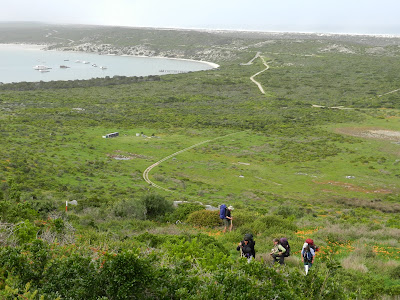We enjoy exploring new places and hiking, and wanted to organise a five day hike in a new area for a group of hiking friends. We heard about the Oorlogskloof Nature Reserve, near Nieuwoudtville, which sounded as if it might be worth further research. The Reserve has three day hikes of varying lengths and two longer hikes (4-5 days and 5-7 days). We decided to take a few days off and do an advance recce.
 |
One of the cracks on the Trail - there are a
few ladders to negotiate. |
We left Cape Town on a Sunday morning, and arrived at our self-catering cottage – ‘Bokmakierie’ shortly after 2.00p.m. Bokmakierie is on a smallholding on the outskirts of Nieuwoudtville, but is within walking distance of the village (5 minutes). We settled in and slowly started to unwind, and appreciate the view from the kitchen door - the sheep next door, a windmill close enough to hear it turning, and green fields as far as the eye could see (this was July!) We spent a couple of hours strolling round the village, exploring some very old dilapidated stone houses, and the stone buildings along the main road. Back in our temporary home, we made a fire, put our electric blankets on to warm up the bed, and curled up on the couch with a plate of spaghetti bolognaise and a couple of good books . The next morning (Monday) we booked an evening meal at a restaurant in the Main Road – ‘Die Nedersetting’ and picked up our permits at the Department of Nature Conservation for a day hike in the
Oorlogskloof Nature Reserve which is 16km out of Nieuwoudtville. We choose the Leopard Trap Day Hike which is 15.5km and passes a very old stone leopard trap and a magnificent view of the knersvlakte, (north of Vanrhynsdorp) from the top of the escarpment. The trail was pretty rugged for the first couple of kms, and we found ourselves clambering over large rocks, climbing ladders and squeezing through cracks on koppies.
 |
| The Leopard Trap |
We wondered how we would fare with a heavy pack, particularly after one km took us an hour to walk. The trail soon became easier and we began to make good time. The Reserve estimated the 15.5km would be a 6 to 9 hour hike. We managed 6¼ hours, which excluded our stop for lunch. The trail took us through renosterbos and Bokkeveld fynbos. We arrived back at the car feeling well exercised, and agreed that we would organise a group hike to return to Oorlogskloof Nature Reserve in late September.
http://www.footprint.co.za/oorlogskloof.htm
That evening was our ‘night out’ at 'Die Nedersetting'. We were greeted by Wessie and shown to our table in front of a roaring fire. We were able to ask for wine by the glass which suited us and, as we had chosen our meal that morning, we were soon tucking into venison pie and vegetables. Wessie and Hester, the co-owners, were quite happy to answer our questions about the town, ‘boerekos’ and tips on the cooking thereof, and they told us about their ideas of expanding the accommodation and dining facilities. We ordered malva pudding with custard for dessert, and coffee, and left feeling well warm, relaxed and well fed after perfect Afrikaner hospitality.
http://www.getaway.co.za/article/nedersetting-restaurant-Niewoudtville
Tuesday was our sightseeing day. Nieuwoudtville has many beautiful, old, Victorian-style, sandstone buildings built from the locally quarried stone. One such building is the Dutch Reformed church built with local, dressed sandstone in 1906/7 on land donated by the Niewoudt brothers – well worth a visit. The local garage has a fascinating collection of vintage motor bikes and dinky cars.
 |
| Nieuwoudtville Falls |
A short way out of town, towards Loeriesfontein, are the Nieuwoudtville Falls. At the confluence of the Gras Rivier and Willem Rivier which is called Maierskloof, are the falls. Both the Gras and Willem Rivers begin closer to the edge of the escarpment and flow inland and together form the Doring River. The falls are spectacular and fall 100 metres into a large pool far below in a deep ravine.
The road ends at Loeriesfontein which is a town well worth a visit. The Fred Turner Museum has a fascinating collection of Afrikaner memorabilia and a collection of windmills. The elderly curator heard that we were visiting, and came to open the hall specially for us!
On the return trip, we took the detour to the Kokerboom or Quiver Tree forest. This is not far from the main road and is the largest and most southern forest of Aloe dichotoma. These Aloes only grow on north-facing slopes and flower in June/July.
 |
| A Kokerboom in flower |
We arrived back at ‘Bokmakierie' as the sun was setting and braaied our locally bought lamb saddle chops and boerewors over the sitting room fire. A perfect end to our day.
Wednesday was our ‘return home’ day. We slowly packed up, fed our left-over milk to a wandering cat and drove south towards the Matjiesfontein Farm Stall. Unfortunately it is closed over winter, but we stopped at the glacial floor, 10km out of Nieuwoudtville. These are tracks in the stone, formed by the movement of ice over Southern Africa when it migrated over the south pole about 300 million years ago. Interesting, and fascinating if you happen to be a geologist.
We would highly recommend a visit to Nieuwoudtville and the Oorglogskloof Nature Reserve for a short break. We arrived back home refreshed, and well exercised having got good value for our money and time.

























